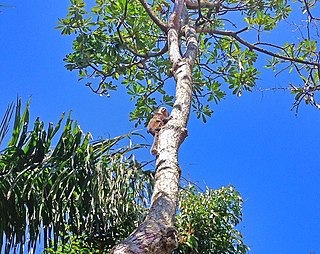This is a list of plants found in the wild in Pantanal vegetation of Brazil.
Contents
- Aizoaceae
- Amaranthaceae
- Amaryllidaceae
- Anacardiaceae
- Annonaceae
- Apocynaceae
- Bignoniaceae
- Clusiaceae
- See also
- References
This is a list of plants found in the wild in Pantanal vegetation of Brazil.

Alternanthera is a genus of flowering plants in the family Amaranthaceae. It is a widespread genus with most species occurring in the tropical Americas, and others in Asia, Africa, and Australia. Plants of the genus may be known generally as joyweeds, or Joseph's coat. Several species are notorious noxious weeds.

Plumeria, also known as frangipani, is a genus of flowering plants in the subfamily Rauvolfioideae, of the family Apocynaceae. Most species are deciduous shrubs or small trees. The species are native to the Neotropical realm, but are often grown as cosmopolitan ornamentals in tropical regions, especially in Hawaii, as well as hot desert climates in the Arabian Peninsula with proper irrigation.

Gomphrena is a genus of plants in the family Amaranthaceae. They are known as the globe amaranths.

Aspidosperma cylindrocarpon is a timber tree native to Brazil, Paraguay, Bolivia, and Peru. It is common in Atlantic Forest, Cerrado and Pantanal vegetation of Brazil. This plant is cited in Flora Brasiliensis by Carl Friedrich Philipp von Martius. In addition, it is useful for beekeeping.

Aspidosperma parvifolium is a timber tree native to Brazil, which is typical of Atlantic Forest, Cerrado, Caatinga, and Pantanal vegetation. This plant is cited in Flora Brasiliensis by Carl Friedrich Philipp von Martius. In addition, it is useful for beekeeping.

Himatanthus is a genus of flowering plant in the family Apocynaceae, first described as a genus in 1819. It is native to Panama and South America.
Annona coriacea is a fruit tree native to Brazil. Its original habitat includes the ecoregions of Cerrado, Caatinga, and Pantanal. There, it is typically found in scrublands and savannahs, though it is sometimes grown in orchards. Its wood is used in constructions and toys. This plant is cited in Flora Brasiliensis by Carl Friedrich Philipp von Martius.

Alstroemeria psittacina, with the common names Peruvian lily, parrot flower, parrot lily, lily of the Incas, princess lily and New Zealand Christmas bell, is a species of flowering plant in the family Alstroemeriaceae. It is found in cerrado and pantanal vegetation in Brazil and Argentina.

Tabebuia roseo-alba, known as white ipê, ipê-branco or lapacho blanco, is a tree native to Cerrado and Pantanal vegetation in Brazil, but also appears in Argentina and more rarely in Paraguay.

Tabebuia ochracea, known as corteza amarilla in Spanish, is a timber tree native to South America, Cerrado and Pantanal vegetation in Brazil. It is also known as Handroanthus ochraceus or Tecoma ochracea. It is often confused with the Golden Trumpet Tree, which is known as Handroanthus chrysotrichus or Tabebuia chrysotricha. It is a seasonal flowering tree, blossoming only during spring (September). During this time, all leaves fall and only flowers remain in the crown.

Rollinia is a genus of plants in the family Annonaceae. While it is widely recognised as a distinct genus a monograph published in 2006 advocates its inclusion in Annona, which also contains custard apples and soursops.
This is a list of plants which includes trees and other herbs, vines, climbers, lianas, shrubs, subshrubs that are native or endemic to Cuba.

Brazil has great forests. Minas Gerais, Brazil's central state, larger domain is the tropical forest. Within it there are many types of plants. Separated by families this is a list of these plants:

Duguetia is a genus of trees and shrubs in the plant family Annonaceae with approximately 90 species in central and South America, and four species in west Africa.